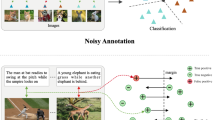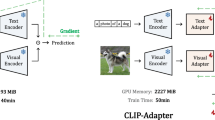Abstract
Zero-shot learning (ZSL) aims to recognize new unseen classes by transferring knowledge from seen classes, which assumes that both seen and unseen classes share a common semantic space. Mainstream ZSL methods focus on learning visual-semantic projection by one-vs-all strategy in which the class-level attribute vector is matched with many visual features. However, human-annotated attributes have some limitations: 1) The attribute semantics are subjective to be manually annotated, which could lead to inaccuracy. 2) Since human-annotated attributes may focus on details, some attributes are weakly associated with the object and contribute little information to recognition. Meanwhile, most ZSL methods also suffer from the severe problem of domain shift problem. Thus, in this paper, we propose a novel ZSL model to address the above problems. Specifically, we introduce the attribute relabeling approach to rectify the original attributes by exploiting the intrinsic attribute correlation information. Then, we employ the property of group-wise competition of exclusive lasso to encourage different categories to compete for prominent category-specific attributes, respectively, which benefits learning visual-semantic projection. Besides, our model integrates the encoder-decoder paradigm to alleviate the projection shift problem. Extensive experiments on three benchmark datasets demonstrate the superiority of the proposed model. In particular, in the setting of generalized ZSL, our proposed model has higher unseen class accuracy and thus achieves the highest harmonic mean value.






Similar content being viewed by others
References
Boyd S, Parikh N, Chu E (2011) Distributed optimization and statistical learning via the alternating direction method of multipliers. Now Publishers Inc
Changpinyo S, Chao WL, Gong B, Sha F (2016) Synthesized classifiers for zero-shot learning. In: Proceedings of the IEEE conference on computer vision and pattern recognition, pp 5327–5336
Chao WL, Changpinyo S, Gong B, Sha F (2016) An empirical study and analysis of generalized zero-shot learning for object recognition in the wild. In: European conference on computer vision. Springer, pp 52–68
Ding Z, Liu H (2019) Marginalized latent semantic encoder for zero-shot learning. In: Proceedings of the IEEE/CVF conference on computer vision and pattern recognition, pp 6191–6199
Frome A, Corrado G, Shlens J, Bengio S, Dean J, Ranzato M, Mikolov T (2013) Devise: A deep visual-semantic embedding model
Fu Y, Hospedales TM, Xiang T, Gong S (2015) Transductive multi-view zero-shot learning. IEEE Transactions on Pattern Analysis and Machine Intelligence 37(11):2332–2345
Guo Y, Ding G, Han J, Tang S (2018) Zero-shot learning with attribute selection. In: Thirty-second AAAI conference on artificial intelligence
He K, Zhang X, Ren S, Sun J (2016) Deep residual learning for image recognition. In: Proceedings of the IEEE conference on computer vision and pattern recognition, pp 770–778
Jiang H, Wang R, Shan S, Yang Y, Chen X (2017) Learning discriminative latent attributes for zero-shot classification. In: Proceedings of the IEEE international conference on computer vision, pp 4223–4232
Jiang H, Wang R, Shan S, Yang Y, Chen X (2017) Learning discriminative latent attributes for zero-shot classification. In: Proceedings of the IEEE international conference on computer vision, pp 4223–4232
Keshari R, Singh R, Vatsa M (2020) Generalized zero-shot learning via over-complete distribution. In: Proceedings of the IEEE/CVF conference on computer vision and pattern recognition, pp 13300–13308
Kodirov E, Xiang T, Gong S (2017) Semantic autoencoder for zero-shot learning. In: Proceedings of the IEEE conference on computer vision and pattern recognition, pp 3174–3183
Lampert CH, Nickisch H, Harmeling S (2009) Learning to detect unseen object classes by between-class attribute transfer. In: 2009 IEEE Conference on computer vision and pattern recognition. IEEE, pp 951–958
Li D, Liu H, Zhang Z, Lin K, Fang S, Li Z, Xiong NN (2021) Carm: Confidence-aware recommender model via review representation learning and historical rating behavior in the online platforms. Neurocomputing 455:283–296
Li J, Jing M, Lu K, Zhu L, Yang Y, Huang Z (2019) From zero-shot learning to cold-start recommendation. In: Proceedings of the AAAI conference on artificial intelligence, vol 33, pp 4189–4196
Li X, Fang M, Feng D, Li H, Wu J (2019) Prototype adjustment for zero shot classification. Signal Processing: Image Communication 74:242–252
Li Z, Liu H, Zhang Z, Liu T, Xiong NN (2021) Learning knowledge graph embedding with heterogeneous relation attention networks. IEEE Transactions on Neural Networks and Learning Systems
Lin G, Fan C, Chen W, Chen Y, Zhao F (2018) Class label autoencoder for zero-shot learning. arXiv:1801.08301
Liu G, Guan J, Zhang M, Zhang J, Wang Z, Lu Z (2019) Joint projection and subspace learning for zero-shot recognition. In: 2019 IEEE International conference on multimedia and expo (ICME). IEEE, pp 1228–1233
Liu H, Fang S, Zhang Z, Li D, Lin K, Wang J (2021) Mfdnet: Collaborative poses perception and matrix fisher distribution for head pose estimation. IEEE Transactions on Multimedia
Liu T, Liu H, Li Y, Zhang Z, Liu S (2018) Efficient blind signal reconstruction with wavelet transforms regularization for educational robot infrared vision sensing. IEEE/ASME Transactions on Mechatronics 24(1):384–394
Liu T, Liu H, Li YF, Chen Z, Zhang Z, Liu S (2019) Flexible ftir spectral imaging enhancement for industrial robot infrared vision sensing. IEEE Transactions on Industrial Informatics 16(1):544–554
Liu Y, Gao Q, Li J, Han J, Shao L (2018) Zero shot learning via low-rank embedded semantic autoencoder. In: IJCAI, pp 2490–2496
Ming D, Ding C (2019) Robust flexible feature selection via exclusive l21 regularization. In: Proceedings of the 28th international joint conference on artificial intelligence, pp 3158–3164
Norouzi M, Mikolov T, Bengio S, Singer Y, Shlens J, Frome A, Corrado GS, Dean J (2013) Zero-shot learning by convex combination of semantic embeddings. arXiv:1312.5650
Patterson G, Xu C, Su H, Hays J (2014) The sun attribute database: beyond categories for deeper scene understanding. Int J Comput Vis 108(1-2):59–81
Rahman S, Khan S, Porikli F (2018) A unified approach for conventional zero-shot, generalized zero-shot, and few-shot learning. IEEE Trans Image Process 27(11):5652–5667
Romera-Paredes B, Torr P (2015) An embarrassingly simple approach to zero-shot learning. In: International conference on machine learning. PMLR, pp 2152–2161
Shen X, Yi B, Liu H, Zhang W, Zhang Z, Liu S, Xiong N (2019) Deep variational matrix factorization with knowledge embedding for recommendation system. IEEE Transactions on Knowledge and Data Engineering
Shigeto Y, Suzuki I, Hara K, Shimbo M, Matsumoto Y (2015) Ridge regression, hubness, and zero-shot learning. In: Joint european conference on machine learning and knowledge discovery in databases. Springer, pp 135–151
Simonyan K, Zisserman A (2014) Very deep convolutional networks for large-scale image recognition. arXiv:1409.1556
Socher R, Ganjoo M, Sridhar H, Bastani O, Manning CD, Ng AY (2013) Zero-shot learning through cross-modal transfer. arXiv:1301.3666
Szegedy C, Liu W, Jia Y, Sermanet P, Reed S, Anguelov D, Erhan D, Vanhoucke V, Rabinovich A (2015) Going deeper with convolutions. In: Proceedings of the IEEE conference on computer vision and pattern recognition, pp 1–9
Wang W, Pu Y, Verma VK, Fan K, Zhang Y, Chen C, Rai P, Carin L (2018) Zero-shot learning via class-conditioned deep generative models. In: Thirty-second AAAI conference on artificial intelligence
Xian Y, Lampert CH, Schiele B, Akata Z (2018) Zero-shot learning—a comprehensive evaluation of the good, the bad and the ugly. IEEE Transactions on Pattern Analysis and Machine Intelligence 41 (9):2251–2265
Yu Y, Ji Z, Guo J, Zhang Z (2018) Zero-shot learning via latent space encoding. IEEE Transactions on Cybernetics 49(10):3755–3766
Yu Y, Ji Z, Guo J, Zhang Z (2018) Zero-shot learning via latent space encoding. IEEE Transactions on Cybernetics 49(10):3755–3766
Zhang Z, Saligrama V (2016) Zero-shot learning via joint latent similarity embedding. In: proceedings of the IEEE conference on computer vision and pattern recognition, pp 6034–6042
Zhang Z, Saligrama V (2016) Zero-shot learning via joint latent similarity embedding. In: proceedings of the IEEE conference on computer vision and pattern recognition, pp 6034–6042
Zhang Z, Xie Y, Yang L (2018) Photographic text-to-image synthesis with a hierarchically-nested adversarial network. In: Proceedings of the IEEE conference on computer vision and pattern recognition, pp 6199–6208
Zhu Y, Elhoseiny M, Liu B, Peng X, Elgammal A (2018) A generative adversarial approach for zero-shot learning from noisy texts. In: Proceedings of the IEEE conference on computer vision and pattern recognition, pp 1004–1013
Author information
Authors and Affiliations
Corresponding author
Additional information
Publisher’s note
Springer Nature remains neutral with regard to jurisdictional claims in published maps and institutional affiliations.
Rights and permissions
About this article
Cite this article
Mi, JX., Zhang, Z., Tai, D. et al. Attribute self-representation steered by exclusive lasso for zero-shot learning. Appl Intell 53, 3095–3108 (2023). https://doi.org/10.1007/s10489-022-03497-1
Accepted:
Published:
Issue Date:
DOI: https://doi.org/10.1007/s10489-022-03497-1




